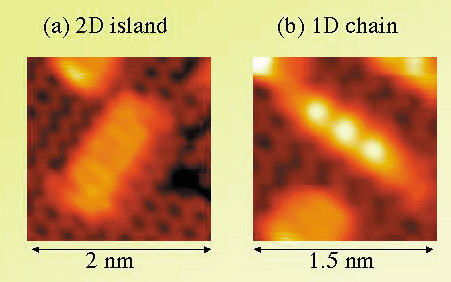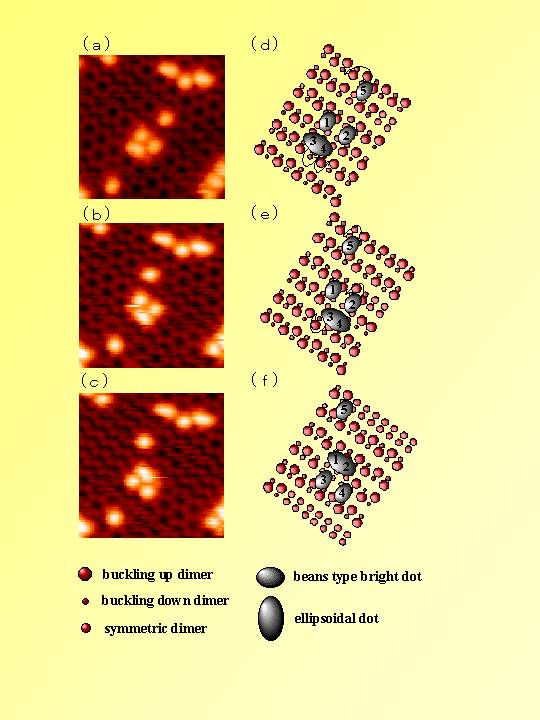Correlated Motion of Small Ag Clusters and Ge Dimer-Buckling on Ge(001) as a Precursor Process of Surface Alloying
Yoshitaka Naitoh, Kan Nakatsuji and Fumio Komori
ref.) Correlated motion of small Ag clusters and Ge dimer buckling on Ge(001), J. Chem. Phys.117 (2002) 2832. ; Formation process of very thin Ag structures on Ge(001) surfaces, Surf. Sci. 513 (2002) 1.
The motion of atoms and small clusters at surfaces is an important subject not only for the fundamental understanding of the stability of material but also for the fabrication of novel and functional materials by such as alloying or chemical reactions. Still the dynamical processes prior to the alloying at surfaces have not been well studied.
Among various surface alloys and compounds, Ag on clean Ge(001) has attained a special interest since the discovery of superconductivity below 2 K.[1] This system is a candidate for the superconducting surface alloy because Ag and Ge are immiscible and not superconductors in the bulk. The growth of Ag on Ge(001) has been previously studied by scanning tunneling microscopy (STM) at room temperature (RT). [2] When sub-monolayer (ML) Ag is deposited on Ge(001) surfaces at 90 K, they form 1 ML thick two dimensional (2D) islands and one-dimensional (1D) chains after annealing at RT as shown in Fig. 1. The 2D island is stable at RT and the corrugation on the island is small in STM observations. This suggests that alloying occurs at the Ag-Ge interface during the annealing to RT.
We have studied Ag on Ge(001) surfaces by STM at temperatures between 65 K and RT to understand the processes of Ag island formation and their intermixing into the Ge surface by increasing the temperature. Silver was always deposited at 90 K. The deposited Ag atoms or their small aggregates are randomly located at various sites on Ge(001) at 78 K, and are observed as small and large bright dots in the STM images. Some of the dots move on the surface with keeping the phase of the substrate Ge dimer buckling. By increasing the sample temperature, the bright dots diffuse, transform and assemble into small clusters, which are still one mono atomic layer thick. Finally, above 200 K, the clusters occupying three Ge dimer rows transform into the 2D islands with small corrugation. The images inside the 2D island and the 1D chain were found not to be the cluster types of the bright dots. This suggests Ag dots move on the surface and intermix or alloy with the substrate Ge atoms during the annealing.
On 0.2 ML Ag deposited Ge(001) after annealing at 180 K for 2 hours, we found the clusters made of the large dots as well as isolated large dots. Figures 2 show successive STM images with 5 min interval, and their models. As in the models, the thermally-activated motion of the Ag dots causes the buckling change of the Ge dimer and vice versa at this temperature. Especially, the movement of the bright dots along the dimer row in the cluster induces the simultaneous formation and separation of the ellipsoidal dots with correlated change of the buckling phase at the Ge dimer rows under the cluster. These correlated motions are precursor processes to the formation of the 2D alloy islands above 200 K.
References
[1] M.J. Burns, J.R. Lince, R.S. Williams and P.M. Chaikin, Solid State Commun. 51 865 (1984).
[2] F. Komori, K. Kushida, K. Hattori, S. Arai and T. Iimori, Surf. Sci. 438 123 (1999).

Figure 1 STM images of 0.35 ML Ag deposited Ge(001) surface at 90 K, observed at 65 K after 13 hours annealing at RT. The 2D island (a) and the 1D chain (b) are formed on this surface. The former elongates along the Ge dimer row direction and occupies three dimer rows. The latter elongates along the Ge dimer direction and has mono-atomic width.

Figure 2 (a-c) Successive STM images at 180 K with about 5 min interval including a cluster made of two kinds of the Ag dots on three Ge dimer rows.
(d-f) Schematic diagram of the dots and the cluster motion in (a-c). In (a, d), two bright dots indicated by 1, 2 are located in the trough between Ge dimer rows, and an ellipsoidal dot, indicated as 3-4, is located in the lower left adjacent trough between the rows. Next in (b, e), the location of the ellipsoidal dot moves to the lower right side along the Ge dimer row. In the third (c, f), the locations of the two bright dots and an ellipsoidal dot are exchanged. T The isolated large dot indicated by 5 in the figures also moves along the Ge dimer row.

